

Keys Are The Sure Way To Build Songs!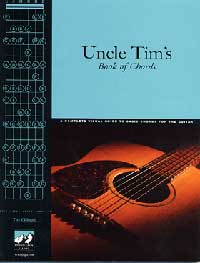
Keys seem to be the hidden ingredient to playing a guitar. Once you know keys you can immediately start playing the chords in the key and constructing songs based on the chords in the key.
Triads are the simplest chords you can create and they flow up and down the fretboard providing easy access to any chord in any key with hardly any effort.
And when you are constructing a song, there is no better tool available anywhere. And the knowledge you get will set you free!
There is nothing like it and nothing that can make composing songs as easy as this. For $20, you can have a resource that will always show you all the choices for where you are working. Pick up a copy today.
eBooks are delivered instantly!
By Tim Gillespie
To begin our study of the twelve bar blues we are going to work out of the key of E major. I made this decision based on the location of the fifth or power chord I want to work from. Anything we do today can easily be transposed to another key on the fly. This stuff is actually pretty simple.
So here are the chords we are going to use. They are the E major, A major and B major.


 Notice
we are going to work out of the open string area. Also notice the B
major is the same form as the A major, it is just moved up two frets.
The open string notes in the A major are played as a barre chord in
the B major. Sliding between these two chords fits very nicely.
Notice
we are going to work out of the open string area. Also notice the B
major is the same form as the A major, it is just moved up two frets.
The open string notes in the A major are played as a barre chord in
the B major. Sliding between these two chords fits very nicely.
These chords comprise the one, four and five degrees of a major key. This is the I-IV-V (1, 4, 5) progression.


![]() When
we play the rhythm using the E major chord, we are going to start by playing
the fifth instead of the full chord. The fifth is the second diagram with
only the E and B notes. Play the B note with your second finger. Go ahead
and play those two notes if you want to try it. Notice you get the full
bodied sound. Now try playing the open E and C# notes (a sixth). Play
the C# note with your third finger and the B note with your index finger.
When
we play the rhythm using the E major chord, we are going to start by playing
the fifth instead of the full chord. The fifth is the second diagram with
only the E and B notes. Play the B note with your second finger. Go ahead
and play those two notes if you want to try it. Notice you get the full
bodied sound. Now try playing the open E and C# notes (a sixth). Play
the C# note with your third finger and the B note with your index finger.

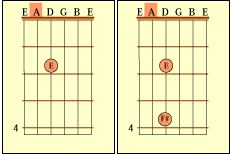
![]() We
are going to do the same thing with A major. Now we are going to play
the E note with the index finger and the F# note with the third finger.
We
are going to do the same thing with A major. Now we are going to play
the E note with the index finger and the F# note with the third finger.
Timing. Count 1 & 2 & 3 & 4 & for each measure. Each box below is a measure. I have kept this piece simple because we are more concerned with getting familiar with this progression. Usually you polish the piece much later in the process. Making it sound so polished might make someone think that is how it always sounds when in fact the song can be somewhat rough until everything is recorded several times and mixed down. So don't worry if your progression is a little rough at first. If you play this about 200 times you will develop a better feel for it.
Bar 1 - One Chord -E Major Bar 2 - One Chord -E Major Bar 3 - One Chord -E Major Bar 4- One Chord -E Major




Bar 5 - Four Chord - A Major Bar 6 - Four Chord - A Major Bar 7- One Chord - E Major Bar 8 - One Chord - E Major




Bar 9 - Five Chord - B Major Bar 10 - Four Chord - A Major Bar 11 - One Chord -E Major Bar 12 - Five Chord - B Major




So the progression is;
4 bars of the tonic chord.
2 bars of the subdominant chord
2 bars of the tonic chord.
1 bar of the dominant chord.
1 bar of the subdominant chord.
1 bar of the tonic chord.
1 bar of the dominant chord. This is called the turn around because
it sets the progression up to repeat.
![]() Click
on the icon to hear twelve bars of the blues.
Click
on the icon to hear twelve bars of the blues.
So this progression is only three chords with a few quick changes in the final four bars. I often switch between playing the fifths (power chords) and the full chord. You can do this whenever you want, but if you play this enough you will see there are opportune times for each type of chord. Experiment with this and see what you like.
Scales
Although we are not going to look at lead lines this month, I would like to point out that the E major scale will work very well with these chords. Hammer ons with the high E and B strings work nicely too. Just make sure you hammer the notes of E major. If you hit notes outside of the key of E major, you will hear it and you may not like it. You can easily substitute pentatonic scales for the diatonic scale of E major. As usual start slowly and concentrate on note selection, not speed.
Chord Substitutions
There are two different ways to think about substitutions. First, you can use the same chords only in different positions. For instance let's look at different chords of the same type.


 When
the second twelve bars come around, consider climbing up to this E major
chord (second chord) instead of the open string E major. You can let
the low open E string ring out when you play this.
When
the second twelve bars come around, consider climbing up to this E major
chord (second chord) instead of the open string E major. You can let
the low open E string ring out when you play this.
When you transition to the A chord, try going all the way back down to the open string A, only go right into playing the fifths.

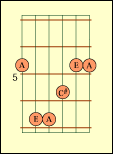
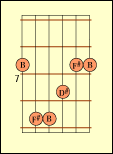
 These
two substitutions are straightforward. They are particularly useful when
you hit the turn around in bar twelve. Try using these higher chords with
the open string chords and fifths to create a more interesting progression.
With these small changes you can create enough interest to mask the general
progression and to cause the listener to pay attention.
These
two substitutions are straightforward. They are particularly useful when
you hit the turn around in bar twelve. Try using these higher chords with
the open string chords and fifths to create a more interesting progression.
With these small changes you can create enough interest to mask the general
progression and to cause the listener to pay attention.
Seventh Chords
This series of substitutions can change the entire feeling of the progression. These are substitutions that I use regularly because they inject a level of sophistication I find appealing. I strongly suggest you experiment with these because they present a marvelous opportunity to understand how a seventh chord can alter the sound.

 Substitute
the E 7 for the E major. Start out by strumming these chord instead
of the E major. You can still use the fifths but you won't hear the differences
this chord injects. So at first, just strum the chords.
Substitute
the E 7 for the E major. Start out by strumming these chord instead
of the E major. You can still use the fifths but you won't hear the differences
this chord injects. So at first, just strum the chords.

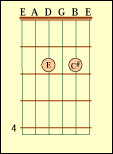
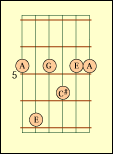 Substitute
the A 7 for the A major. By the time you hit this chord, the differences
in the feeling of the progression should be obvious. The jazzy feeling
of seventh chords is unmistakable. You can also substitute this seventh
chord to the right.
Substitute
the A 7 for the A major. By the time you hit this chord, the differences
in the feeling of the progression should be obvious. The jazzy feeling
of seventh chords is unmistakable. You can also substitute this seventh
chord to the right.

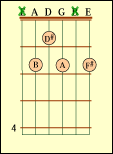
 Substitute
the B 7 for the B major. The substitutions are a little harder to
play since the fingerings are more complex.
Substitute
the B 7 for the B major. The substitutions are a little harder to
play since the fingerings are more complex.
With these chords you can change the feeling of the progression, mix the distance between chords and jump into a higher or lower octave. These options are quite varied and if you choose wisely you should be able to keep the interest level high.
So there you have it, a basic introduction to the twelve bar blues. This is just the beginning. This concept can be applied to any key under all sorts of conditions. The one thing the twelve bar blues have in common is the sound. With a little ear training, you will recognize this signature sound in all sorts of music.
The more you play this, the better it will sound. Have fun.